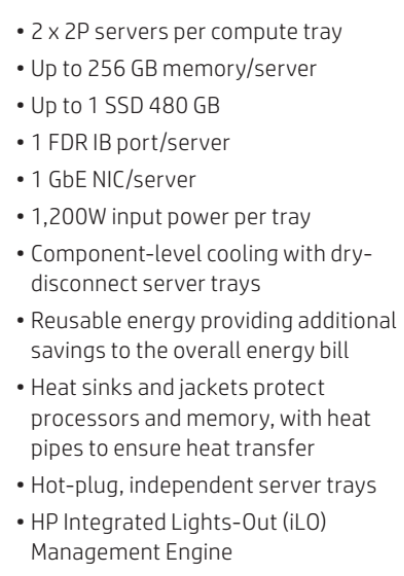HP has announced a new family of high performance computing systems that target a balance between high density, energy efficiency, and raw performance. The line, called “HP Apollo” is divided in half for key workloads and needs, with the air-cooled Apollo 6000 system aimed at enterprise users and the liquid-cooled Apollo 8000 focused on large-scale supercomputing sites.
As many remember, last year we followed the announcement of the new Peregrine supercomputer at the National Renewable Energy Laboratory (NREL). The warm water-cooled system set the bar for efficiency, but little did we know then that HP would roll out an entire line to replicate that success. HP saw the value of the approach while completing the system for NREL and has since learned lessons about expanding the same system for both new and existing air-cooled datacenters. They’re hoping the balanced push of high density and big energy savings will speak both to the national lab set and commercial datacenter operators who don’t have the luxury of, say a Facebook, to build as big as they wish with the comfort of cheap power that they can blow back into the sky as waste heat.
The Apollo system features a scalable rack design that allows for 144 servers in a rack, which HP says means “four times the teraflops per rack compared to air-cooled designs.” HP’s Ed Turkel said that this translates into the elimination of over 3.800 tons of carbon dioxide waster from a datacenter over the course of a year. Further, the Apollo 8000 features a patented, novel warm water cooling system that HP’s Ed Turkel provides “liquid cooling without the risk.” HP’s approach avoids the use of dripless connectors and other safeguards against water touching any of the components. The cooled components release hot water, which can be recirculated to provide building heat. In fact, one of the prime sites to see the Apollo 8000 line in action is where it was conceptualized—at the NREL Peregrine supercomputer site.
The Apollo 8000 at its base starting line consists of an Apollo 8000 standard-sized rack and the Apollo 8000 iCDU rack.
These are outfitted with the HP Proliant XL730f server and HP’s InfiniBand switch.
As Turkel told us, when NREL set forth designing the type of system that would showcase their position as both an energy efficient research leader as well as practitioner of efficient practices, they knew that part of their design would incorporate warm water cooling. This initial RFP set HP’s development wheels in motion as the team tried to find a way to integrate risk-free, high-density water-cooled supercomputing capabilities at NREL within space and budget limitations.
Luckily, NREL was able to design the center from the ground up to accommodate the plumbing and other infrastructure to support both a water cooled supercomputer and the ability to carry the waste heat in water form throughout the building, but Turkel says that his team is confident that retrofitting an air-cooled datacenter for the same environment NREL has is also practical and affordable, especially after their work in making some of the piping and other components more “modular” in nature so user facilities can circumvent some of the custom pipe cutting that had to go on at the first NREL site.
Turkel said that one testament to the success of the datacenter waste heat’s potential to heat the area is the fact that the sidewalk leading up to the NREL supercomputing site is always free of ice and snow during the cold Colorado winter. NREL extended the pipes that carry heat from the servers to just under the pavement.
But for NREL, the project means more than recycling supercomputer heat—it has lead to close to a million dollars in energy savings, both in heating costs and in overall efficiency of the supercomputers themselves. Further, since the components run at a stable temperature, they’re able to operate their Xeon Phi in ongoing turbo mode.
This is a huge improvement in how NREL has designed and implemented new supercomputing facilities. Steve Hammond, director of Computational Sciences at NREL, compared the current trend of air cooling to setting a glass of lemonade on a kitchen counter during a hot summer day and keeping it cold by cranking up the air conditioning in the room. “It’s incredibly wasteful—it just doesn’t make sense,” he told us.
“For us, warm water cooling was the key approach to making the efficiency targets work. As a cooling medium, liquids have about 1,000 times the efficiency of air,” said Hammond. “A juice glass full of water has the cooling capacity of a room full of air. And the pump energy needed to move that juice glass of water, to eject the heat from the system, is less than the fan energy needed to move that room full of air—much less.”
A great deal of the decision to move to hot water cooling was fed by existing problems, both because of efficiency or safety, with current solutions on the liquid and air-cooling fronts. As Hammond explained, making the decision to circulate past the air cooling decision was simple because the inefficiencies and waste are clear.
While many of the hyperscale datacenter giants tend to use air cooling, their greenfield facilities are placed where space and power are cheap and plentiful. Although certainly not the most efficient or carbon-aware, many HPC datacenters, including the new high performance computing facility where the Peregrine supercomputer is housed at NREL, are limited all around—space is a precious commodity and the thought of wasting all of the heat generated by their constant research by blowing it up into the sky would be completely counter to their center’s mission of “practicing what is preached” in terms of energy research.






























































